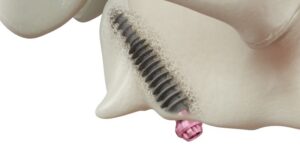Invisalign clear aligners are removable orthodontic appliances offered as an alternative to more traditional orthodontic solutions. A type of clear tooth aligner, Invisalign is intended for people who find the idea of a mouthful of metal braces and brackets – however effective – too unattractive to commit to. If you’re a candidate, you can maintain your smile aesthetics while straightening your teeth.
The Invisalign Clear Aligners System
Are You a Candidate?
According to researchers and Align Technologies, Invisalign can be used to correct the following types of mild dental problems:
- Overly crowded teeth. When there is not enough room in the jaw for all of the teeth to fit comfortably or normally (one to five millimeters).
- Widely spaced teeth. When there is too much space between the teeth due to abnormal growth of the jaw or shifting of the teeth due to missing teeth (one millimeter to five millimeters).
- Overbite/overjet. When the upper teeth bite over the lower teeth.
- Crossbite. When the upper and lower jaws are misaligned, causing one or more upper teeth to bite on the inside of the lower teeth, on either the front and/or sides of the mouth.
- Mild relapse. After traditional braces have been removed, when some relapsing tooth movement has occurred.
- Invisalign may also be a treatment alternative for certain simple malocclusions (bite irregularities).
Invisalign Clear ALigners candidates tend to represent a smaller group than traditional dental braces candidates. This is primarily due to the fact that Invisalign is more limited in terms of treating serious orthodontic cases. Whereas traditional dental braces can treat complex malocclusions, Invisalign might not be an option. However, for simpler orthodontic fixes, Invisalign offers a shorter-duration option called Invisalign Express. This is a less-expensive, abbreviated version of Invisalign.





